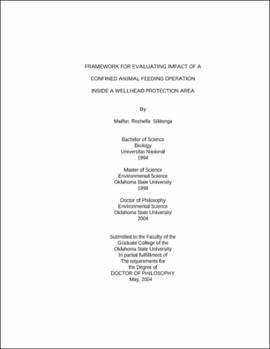| dc.contributor.advisor | Smolen, Michael D. | |
| dc.contributor.author | Silitonga, Maifan Rochella | |
| dc.date.accessioned | 2013-11-26T08:29:51Z | |
| dc.date.available | 2013-11-26T08:29:51Z | |
| dc.date.issued | 2004-05 | |
| dc.identifier.uri | https://hdl.handle.net/11244/7117 | |
| dc.description.abstract | Scope and Method of Study: The purpose of the study is to develop a means of assessing the risk of nitrate contamination of a public well from a CAFO operation inside or near a wellhead protection area. The study focuses on the effect of nitrate contamination of groundwater from the waste lagoon and effluent application to cropland. The waste lagoon liner was 0.5 m thick with K of 10-9 m/s; depth 3 m; 27 m of loamy sand between the lagoon and the aquifer. Application scenarios were: Disposal (D), Low Crop Yield Goal (LYG), High Crop Yield Goal (HYG), and Split Application (SA). Each scenario was examined at two concentrations (300 and 600 mg/L), applied twice annually. Soil profile consisted of sandy clay loam (2 m) and loamy sand (28.5 m). Scenario D had no supplemental irrigation water; LYG and HYG had supplemental irrigation to meet crop needs; HYG used one-half the land area of LYG to achieve a higher nutrient application rate; SA was the same as HYG with two additional applications per year. Economic impact and cost were assessed considering crop yield and two alternatives for water replacement. Water replacement costs were accrued at the time NO3--N in the public well reaches the MCL of 10 mg/L at the PWS. | |
| dc.description.abstract | Findings and Conclusions: Nitrate plume from the lagoon reached a depth of 7 m in 50 years, well short of the aquifer. The aquifer, with an initial NO3--N concentration of 6 mg/L, reached the MCL latest (32.4 yr) under the D scenario at 600mg/L and earliest under the HYG scenario at 300mg/L. A CAFO located 0.8 km (0.5 miles) outside a wellhead protection area would affect the PWS 14 years later than one inside the wellhead protection area. Scenarios with lower effluent concentration (300mg/L) reached the aquifer earlier than effluent of higher concentration (600mg/L). In the long term, low yield crop production produced lower NO3 final concentration in the aquifer. Split application of effluent reduced nitrate flux concentration. Scenario HYG had a higher Net Present Benefit (NPB) than scenario D, because Bermudagrass production offsets some of the cost of waste management. In the event the NO3--N concentration at the PWS reaches the MCL, replacement by drilling new wells would be cheaper than purchasing water from a nearby city. | |
| dc.format | application/pdf | |
| dc.language | en_US | |
| dc.rights | Copyright is held by the author who has granted the Oklahoma State University Library the non-exclusive right to share this material in its institutional repository. Contact Digital Library Services at lib-dls@okstate.edu or 405-744-9161 for the permission policy on the use, reproduction or distribution of this material. | |
| dc.title | Framework for evaluating impact of a confined animal feeding operation inside a wellhead protection area | |
| dc.contributor.committeeMember | Brown, Glenn O. | |
| dc.contributor.committeeMember | Hamilton, Douglas W. | |
| dc.contributor.committeeMember | Stoecker, Arthur | |
| dc.contributor.committeeMember | Focht, William J. | |
| osu.filename | Silitonga_okstate_0664D_1030 | |
| osu.accesstype | Open Access | |
| dc.type.genre | Dissertation | |
| dc.type.material | Text | |
| dc.subject.keywords | cafo | |
| dc.subject.keywords | groundwater | |
| dc.subject.keywords | nitrate | |
| dc.subject.keywords | wellhead protection area | |
| thesis.degree.discipline | Environmental Science | |
| thesis.degree.grantor | Oklahoma State University | |
